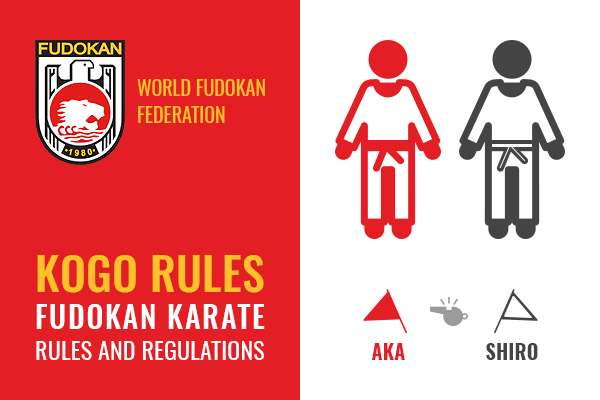KOGO KUMITE RULES for Karate Fudokan Competitions
International Fudokan Karate Rules and Regulations
2012 edition by World Fudokan Federation

In prezentul document, Reguli de KOGO KUMITE in Karate Fudokan - "KOGO RULES - International Fudokan Karate Rules and Regulations" by World Fudokan Federation, publicat in 2012, am pastrat limba originala in care a fost publicat documentul pentru a transmite cat mai corect nuantele si intelesul acestuia. Regulamentul poate fi downloadat in format PDF. (vezi link la finalul articolului)
KO-GO Kumite RULES
International Fudokan Karate Rules and Regulations
Ko-go Kumite: Definition
Ko-go Kumite is a specific form of Kumite competition which designates competitors as either Offense or Defense at the start of each match.
Ko-go Kumite follows General Kumite Rules with the following exceptions:
Procedure
Competition is divided into six matches. Each competitor is designated "offense" three times and must initiate attack. The other competitor is designated "defense" and must respond to the attack, Remark: Aka (Red) side attacks first and attacks three times in a row, followed by Shiro (White) side.
On elimination chart: Aka is placed on top, Shiro is placed on bottom or Aka on right side of chart, Shiro on left side of chart.
Each match is completely independent. Penalty is not carried over to the next match.
In cases of "Han-soku", "Shi-kkaku", Doctor's Stop or Withdraw, no more matches take place. Opponent is declared the winner.
Winner is determined by calculating total score.
In case of a tie (when the points are equal), then the "Kettei-sen" match takes place in which each competitor attacks and defends three times, but this time, alternately initiating the attack, beginning with Aka (Red) side. In case one side scores "Waza-ari" or "Ippon", then that side is declared winner. If no "Waza-ari" or "Ippon", then total score determines winner. If score is still tied, then the court judges decide on the winner by Tsu-mae decision.
Operation of Competition
(Shu-shin operation)
Shu-shin first announces "Offense" side by showing with left hand to the athlete’s left side position Aka, pronouncing orally Aka, Ko-geki, Ikkai. Hands movement: left hand is fully stretched toward Aka in the level of chest, and after that, banding in the elbow joint initial position which is parallel to the floor. After that, fully stretched with the finger in upright position showing the first attack (Ikkai). This is repeating with two fingers for the second attack (Ni-kai) and after that, the third time, three fingers for the third attack (San-kai).
These commands are performing in one smooth movement of hand.
“Offense” side:
"Defense" side:
Judging Operation
In the following cases, Shu-shin stops the match:
Violations and Penalties
In addition to General Kumite Rules, penalty points are given to the opponent for violations in the following cases:
In case of violation of general Kumite Rules, other than the Ko-go Kumite Rules, Shu-shin gives the penalty after confirming with the court judges, without any informal verbal warning.
Additional Judges Terms and Signals
|
Term |
Method of signaling Shu-shin |
Method of signaling Fuku-shin |
|
|
1 |
Jikan |
Hands form a "T', then with both hands open, palms facing each other at side of head (as in General Kumite Rules "Ato") |
|
|
2 |
Kakushi |
Bring both hands together to backside of body. |
"Offense" side flag moves to back side of body. |
|
3 |
Saki |
Index finger shifting from “Defense” side to “Offense” side. |
Top of flag shifting from “Defense” side to “Offense” side. |
|
4 |
Nige-tai |
"Defense" side hand open with palm pushing backward |
"Defense" side flag, while, pointed straight up, moves to side of body. |
|
5 |
Chika-ma |
Bring both palms together, fingers up, in front of chest area. |
Bring both flagpoles together, tops pointed up, in front of chest area. |
Regulamentul de karate "KOGO RULES - International Fudokan Karate Rules and Regulations" by World Fudokan Federation, publicat in 2012, poate fi vizualizat sau descarcat si in format PDF accesand acest link.
Varianta print a regulamentului poate fi comandata de pe website-ul federatiei sau de pe magazinul Federatiei Mondiale de Karate Fudokan.
The Karate Fudokan FUKUGO Rules according to World Fudokan Federation can be viewed as PDF accessing this link or you can order the book from World Fudokan Federation Shop.
Alege clubul cu care dorești să intri în contact sau discută direct cu Federația Română de Karate Tradițional.
Înscrie-ți clubul pe Harta Karate-ului Tradițional din România. Clubul trebuie să fie acreditat și afiliat FRKT/ETFK/ITKF.
Trimite-ne un eveniment, antrenament sau articol despre Karate Tradițional și noi îl vom publica.
Dacă ai nevoie de ajutor nu ezita să ne contactezi.